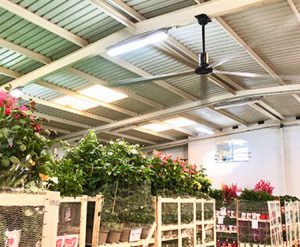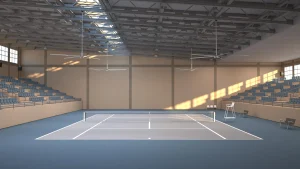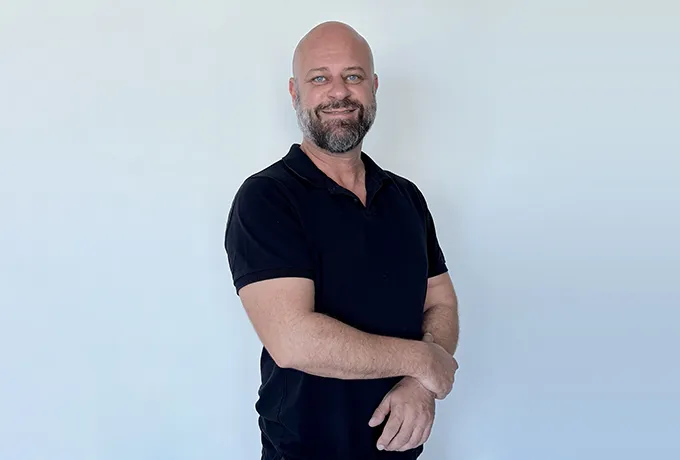Many factories, warehouses, and gyms grapple with soaring energy costs and inconsistent air circulation. This can leave employees feeling tired or overheated, lowering morale and efficiency. Fortunately, a tangible solution exists: installing an Ventilador HVLS can stabilize airflow, optimize climate control, and reduce overhead in significant ways.
Um Ventilador HVLS é um alto volume, baixa velocidade device designed to move large amounts of air gently. The price can range from a few thousand dollars for basic models to higher figures for industrial-grade custom solutions. Factors like diâmetro, motor type, and instalação complexity all influence final costs. Yet, the long-term custos de energia savings typically offset the initial investment.

How Much Does an HVLS Fan Cost
UM ventilador hvls (short for high volume, low speed) is an oversized ventilador industrial engineered to turn at a baixa velocidade while pushing expansive volumes of air. In contrast, a typical ventilador de teto might spin quickly and only legal smaller spots. For grandes espaços, especialmente em industry settings, HVLS designs cover a broader area with minimal noise.
People sometimes assume standard overhead fans can handle everything, but big areas demand specialized tools. HVLS products achieve better coverage than small fans ever could. That’s why many industrial e comercial facilities adopt them to keep worker areas comfortable and safe.
Ventiladores de teto HVLS are indispensable in a armazém environment. Because warm air tends to rise up near the teto, the lower levels remain cooler. That temperature imbalance creates hot and cold pockets, making the environment inconsistent.
By running an HVLS overhead, you recirculate ar quente downward, maintaining a stable indoor climate. Such ventilação not only aids in controle climático but also helps reduce humidity and moisture buildup. These benefits translate into fewer issues with product storage and better conditions for employees.
Warehouses often feature open floor plans, tall columns, and stored goods. An HVLS approach ensures air reaches corners and aisles that would otherwise trap heat. Conventional fans placed on the ground or near aisles rarely have enough coverage to solve this effectively. Hence, HVLS solutions excel in streamlining fresh airflow for all.
Padrão ventilador industrial installations, like barrel or smaller overhead units, can alleviate some discomfort. Yet, if you aim to cut energy costs effectively, an eco hvls system might be the more strategic choice. These fans incorporate specialized designs for baixa velocidade operation while circulating large volumes of air in high-ceiling structures.
The “eco” moniker highlights how a ventilador hvls pode ser custo-efetivo across diverse industry sectors—warehouses, gyms, and even schools. They can regulate temperatures by distributing hot or legal zones more evenly, ultimately fostering more stable conditions indoors.
The simple act of circulating air with a ventilador hvls can result in reduced consumo de energia over time. By eliminating hot spots and delivering gentle breezes, you minimize over-reliance on HVAC units.
Some facilities report that a single HVLS unit can handle areas that used to require multiple smaller fans, yielding immediate economia de custos. Others find they no longer need the AC running at peak capacity all day. Over months and years, these changes add up, showcasing the value of HVLS industriais soluções.

Ventilador HVLS em uma fábrica
When examining ventilador hvls models, you might stumble upon references like “titan" ou "xp.” These code names indicate product lines featuring distinct diâmetro spans, motor technologies, or specialized controls. Each variant targets unique demands, from mid-sized offices to spacious distribution centers.
Certain HVLS product lines labeled “titan” emphasize rugged motor construction for around-the-clock reliability. They might fit best in extremely large warehouses or manufacturing floors that run multiple shifts daily. Combining sturdy materials with advanced controls, they consistently meet heavy performance requirements.
Meanwhile, “xp” might denote a modular approach that suits multiple espaço configurations. They can come in ceiling fan 20, fan 16, ou fan 24 forms, each targeting different coverage areas. The idea is to provide maximum flexibility—os fãs são projetados with adjustable speeds, tilt angles, or specialized features to match varied occupant densities and industry demands.
VINDUS FAN positions itself by integrating premium motor materials with advanced lâmina contours. This ensures you get both durability and refined airflow. We believe strong synergy with on-site requirements fosters greater comfort and consistent power savings.
O diâmetro de um ventilador hvls is a defining characteristic. A “ceiling fan 20” typically spans 20 feet across, whereas a “fan 24” might measure 24 feet. Meanwhile, a “fan 16” is often 16 feet. Each dimension can be tailored to the espaço you want covered.
(Extended Insight: Chart Comparing Diameters)
Diameter (Feet) | Typical Coverage (Sq Ft) | Ideal for
16 | ~4,000 - 5,000 | Medium workshops
20 | ~6,000 - 7,000 | Larger production zones
24 | ~8,000+ | Very big distribution centers
Ultimately, the correct diameter ensures you’re not under- or over-circulating. Pairing the right fan size with your building dimensions fosters optimum occupant comfort and custos de energia poupança.
When browsing ventilador hvls specs, you might notice airflow stats like 16729 cfm ou 20693 cfm. These numbers reflect how many cubic feet of air the fan can displace per minute—a critical factor in evaluating performance.
A higher CFM-CFM often equates to broader coverage. However, bigger isn’t always better. If your building is smaller or your occupant density is moderate, you don’t want to overdo it. The right synergy between motor output and diâmetro ensures you maintain an ideal environment without wasting energy.
Unlike typical high-RPM fans, HVLS systems rely on slow, powerful rotations. That approach keeps noise minimal even if you’re pushing 20,000+ cfm. This is why so many managers in industry settings shift to HVLS solutions: they get the air movement they need without generating distracting, high-speed turbulence.
VINDUS FAN invests heavily in robust engineer-approved designs. Our fans emphasize consistent cfm, stable torque, and energy-saving rotation speeds over inflated specs. Bottom line: we focus on reliable results, not just flashy numbers.
From distribution centers to large gyms, ventiladores industriais hvls are becoming the norm for any industry that values cost savings, occupant comfort, and minimal maintenance. Because they can recirculate both ar quente in winter and distribute cool breezes during summer, their year-round practicality appeals to numerous business segments.
When you have thousands of square feet under a single roof, climate control can be daunting. HVLS devices help unify the indoor environment, preventing corners from remaining stale or overheated. Additionally, since these fans revolve at a baixa velocidade, they pull minimal electricity compared to a fleet of smaller fans running at full throttle.
| HVLS Benefit | Improved Outcome |
|---|---|
| Cost-Effective Air Circulation | Lower heating and cooling bills |
| Gentle, Wide Airflow | Fewer hot or cold zones |
| Motor Longevity | Consistent performance with minimal upkeep |
| Better Employee Comfort | Higher productivity and morale |

Ventilador HVLS em ambiente de ginásio
Investing in an ventilador hvls is no small decision. Between instalação costs, fan diâmetro choices, and performance guarantees, it’s important to partner with a trusted supplier who understands your necessidades específicas. Reputable providers often have robust hvls fan resources, offering design tips, user manuals, and even site-specific engineering recommendations.
A carefully selected HVLS product can help you realize significant poupança em custos de energia. Many facilities report a payback period of two to four years, thanks to reduced heating in winter and simpler cooling in warmer months. Plus, the melhorar o ar quality fosters a safer, more enjoyable work environment.
How does the cost of an HVLS fan compare to traditional fans?
While an ventilador hvls can cost more upfront, it often replaces multiple smaller units. Over time, poupança de reduced consumo de energia and better performance can offset any higher initial expense.
What is the best diameter for my building?
That depends on teto height, floor layout, and occupant density. A fan 16 ou ceiling fan 20 might suffice for mid-sized espaço, while a fan 24 suits very large or open-plan areas.
Can an HVLS solution help in winter?
Yes. HVLS fans push ar quente near the teto down to occupant level, reducing the load on your heating system. You enjoy more consistent indoor temperatures and can potentially lower the thermostat a few degrees.
Are there specific benefits for gym or sports arenas?
Em um academia, HVLS fosters fresh, well-circulated air. It helps whisk away humidity and sweat odors, keeping participants more comfortable. The gentle breeze also feels refreshing without interfering with athletic activities.
How do I ensure reliability of the motor and blade design?
Look for a product with a solid garantia and proven track record. Os fãs são projetados in various ways, so check if your chosen system meets recognized safety and performance standards.
Whether you’re managing a vast armazém, a bustling sports arena, or a multi-level facility, an HVLS solution could be the key to balanced movimento do ar and year-round comfort. By exploring the right ventiladores de teto hvls, you’ll discover how a grande indústria overhead unit can transform your entire espaço, optimizing worker conditions and enhancing your bottom line. If you’re ready to explore the custo de um hvls system tailored to your operations, consider reaching out to a trusted supplier—it might be the most significant step toward better climate control and operational efficiency.

Olá, eu sou Michael Danielsson, CEO da Vindus Fans, com mais de 15 anos de experiência na indústria de engenharia e design. Estou aqui para compartilhar o que aprendi. Se você tiver alguma dúvida, sinta-se à vontade para entrar em contato comigo a qualquer momento. Vamos crescer juntos!